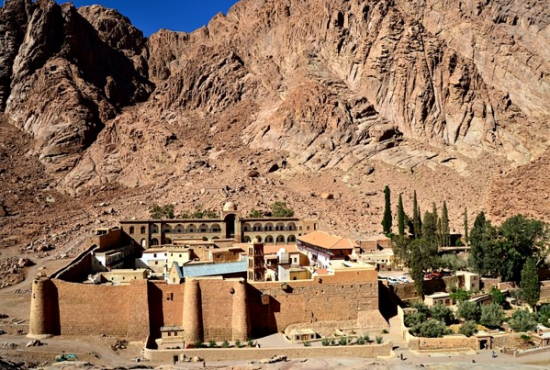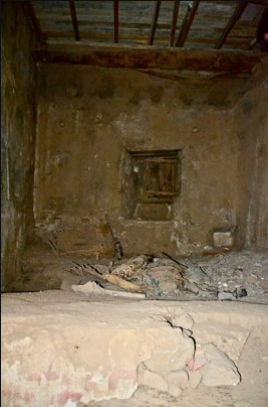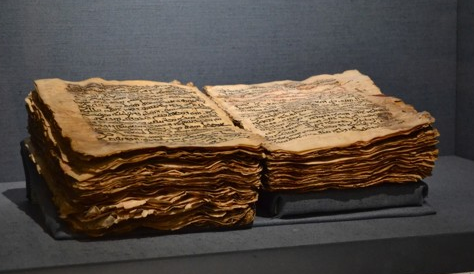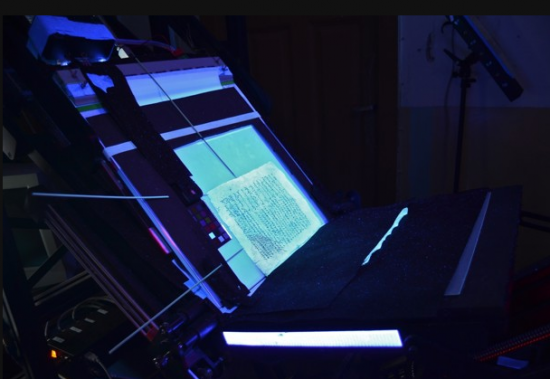Mark Schrope
Source - http://www.washingtonpost.com/lifestyle/magazine/in-the-sinai-a-global-team-is-revolutionizing-the-preservation-of-ancient-manuscripts/2012/08/30/1c203ef4-ca1f-11e1-aea8-34e2e47d1571_story.html

Since at least the 4th century, monks have lived in a valley at the base of Egypt’s Mount Horeb, which leads up to what long tradition says is the Mount Sinai of biblical fame. In the 6th century, the Emperor Justinian I called for construction of a monastery at the site. Many experts consider its collection of ancient manuscripts second in significance only to the Vatican’s huge collection in Rome. Mark Schrope / FOR THE WASHINGTON POST
MOUNT HOREB, Egypt — Michael Toth points at a computer screen filled with what seems to be a jumble of Arabic and Greek letters.
To get to this jumble, he has traveled from Washington to an isolated, fortress-like monastery in the middle of the Sinai Desert, home to the oldest continuously operating library on the planet.
He has helped assemble a global team of scientists that arrived with cutting-edge technology at this spot, three hours by taxi from the nearest commercial airport.
The image he has paused to appreciate is one of a steady stream coming from the room next door, where a high-definition camera is focused on one of the monastery’s rare and priceless ancient manuscripts. The manuscript rests in a cradle that looks like a chair tilted back at an angle, but with hydraulic lines and strange lights attached.

The monastery holds at least 130 palimpsests, all from medieval times. One of the richest sources of palimpsests has been a collection known as the New Finds, discovered in a loft. Mold and insects, the main enemies of book preservation, are not an issue in the desert; neither is humidity. And in this dry place, there are no rats to chew through pages. Mark Schrope / FOR THE WASHINGTON POST
One more room over, in the makeshift command center, specialists are scrutinizing the day’s results, and the monastery’s head librarian, a wispy gray beard to his stomach, waits in a red velvet chair for the next request to turn a fragile manuscript page.
“This is the first time since the 9th century that anyone has seen this,” Toth says of hints of text below the more visible words.

In St. Catherine’s modern museum: the monastery’s most famous palimpsest, the Syriac Sinaiticus, which two intrepid Scottish sisters uncovered in 1892. The overtext was stories of female saints, but the undertext, some of which they glimpsed by steaming pages apart over a tea kettle, proved to be a late-4th-century copy of the four canonical gospels written in the language Old Syriac. Mark Schrope / FOR THE WASHINGTON POST
The first time since the era of Viking invasions and Charlemagne.
The more prominent legible words are 1,200 years old and are interesting enough, but they are not what the scientists are here for. The team is really after the overwritten text from centuries earlier, last seen by the person who scraped it away to recycle the precious animal-skin parchment.
Such erased texts are known as palimpsests, and until their pages enter the imaging room, no one alive now or, in many cases for more than a millennium, can say for sure what has been hidden. The work is tedious, like carefully brushing away sand at a traditional archaeology dig, but the promise of what can be found is a powerful motivator.
This is Toth and his colleagues’ most ambitious project to date, and it is just one component of a major transformation under way in the desert. The team is working within the stone walls of the Sacred and Imperial Monastery of the God-Trodden Mount of Sinai — St. Catherine’s for short.
For 17 centuries, the Greek Orthodox Christian monks here have protected an unparalleled trove of manuscripts. Now the monastery is in a multimillion-dollar push to physically and digitally protect its treasures and make them easily accessible, in most cases for the first time, to scholars around the world.
In the process, the monks will establish a model for the preservation of irreplaceable ancient manuscripts in a world where more and more of them are threatened by the chaos of war and revolution.
“Working with this stuff is an amazing privilege,” Toth says.
St. Catherine’s head librarian, Father Justin, came to Washington in 2008 to learn whether Toth and his colleagues might be able to offer some help. Father Justin had been working to digitize the monastery’s huge manuscript collection using standard photography for 10 or so years. But the time had come to explore the archaeology of the palimpsest subset of the collection with hidden words standard photography can’t reveal. Toth was managing a group that had made a global name for itself in this sort of imaging detective work, an endeavor he entered by accident.
In 1999, Toth, then a policy director at the National Reconnaissance Office, which designs spy satellites and imaging systems, read in The Washington Post about an interesting project at Baltimore’s Walters Art Museum.
An anonymous bidder had paid $2 million at auction for what, on the surface, was a prayer book handwritten in Europe in 1229. But the value came from what the prayers obscured: 10th-century copies of key works by the famed Greek mathematician Archimedes, including the only known copies of some.
Scholars had discovered the hidden text in 1906, but they couldn’t read much of it. After the new owner — still known publicly only as Mr. B — took possession, he agreed to lend the palimpsest to the Walters to try to reveal the rest using advanced imaging techniques.
Toth saw connections between high-tech surveillance imaging and what it was going to take to pull off proper imaging of the palimpsest. On a whim, he e-mailed the museum’s director and offered his services. Soon enough, Toth was volunteering as a project manager, working with Will Noel, a Walters curator overseeing the project, to build the necessary team of scientists.

How it works: Scientists take 31 photos of each manuscript leaf, using different light wavelengths and from different angles. The layers of writing respond differently to the light. The team uses these differences to create processed images that make the erased layer legible.Mark Schrope / FOR THE WASHINGTON POST
The 10-year project pushed the limits of existing technologies, photographing pages using special lights and filters in ways that allowed computerized enhancement of the lost text. It was wildly successful, and by eight years in, Toth had retired from the government to pursue this new passion full time. He is now 55.
Techniques the team developed, not only for imaging but also for managing the massive volume of data such work generates, became standards in the field, and the group began receiving requests to take on new projects involving palimpsests or text lost in other ways, such as through water damage.
Toth and the team — all independent specialists — worked with the Library of Congress to reveal hidden aspects of Thomas Jefferson’s copy of the Declaration of Independence, such as the fact that the founding father had erased the word “subjects” and replaced it with “citizens.” As requests for help piled up, they went global, working in Europe and the Middle East.
In every project, Toth and his colleagues handled the technical side: getting the images. Scholars had to do the analyses. And the team was adamant about making the data public to benefit as many people as possible.
By 2008, Father Justin was one of the people looking them up. The challenge he presented would be nothing like any of the group’s previous projects. Besides the difficulty of getting equipment to the desert and obtaining proper approvals, there was the size of the collection. At that point, all told, Toth and team had imaged perhaps a couple of hundred pages. St. Catherine’s had thousands.
Since at least the 4th century, monks have lived in a valley at the base of Mount Horeb, which leads up to what long tradition says is the Mount Sinai of biblical fame. They came to be close to what they believed, and many today believe, is the burning bush from which God spoke to Moses, as described in the Old Testament.
In the 6th century, the Emperor Justinian I called for construction of a monastery at the site. Today, pilgrims and tourists encounter the 60-foot-high fortress walls and basilica built to fulfill his decree. There are plenty of camels, but visitors who expect to see the rolling sand dunes of movie deserts find instead massive granite cliffs.
PART.2